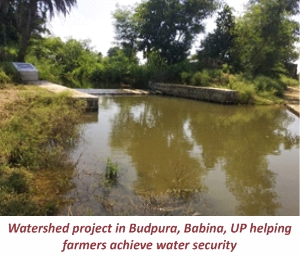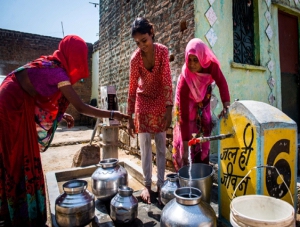Achieving
Water Security during
Corona Pandemic
Bundelkhand,
one of Central India’s most drought prone region’s water problems are on the
rise - rivers, springs, ponds, tanks and streams are drying up and are
heavily degraded due to negligence, unsustainable mining in river beds and
encroachments. The rural communities are the worst hit from the consequences
of global warming and climate change with the persisting problem of lack of
adequate rainfall, consecutive droughts, receding groundwater table. Based
on the Vision Document prepared by the ‘2030 Water Resources Group’ and
Think through Consulting Pvt Ltd, Hindustan times has officiated that the
current water stressed level of Bundelkhand (less than 1700 cubic metre per
capita) will digress further to a water scarce level (less than 1000 cubic
metre per capita) by 2030 if the situation is not helped. To fetch water
from existing sources, the poor people from the rural communities travel far
distances. One such example is seen in the affected village of Ataria
village of Tikamgarh district.
The people go down to the dug wells by forming a human chain, risking their lives for daily water consumption. When water is not enough in Ataria, these people further ride on bicycles or walk 5 kms to fetch water from a private tube well. In many villages, when tankers arrive in the villages, people get injured during the water riots. Many rural communities even continue to migrate in search of water and shelter leaving behind the comfort of their homes, thereby facing extremities and a number of challenges. The agricultural productivity of the region and cattle lives are also threatened from the water shortage. Approximately 70% of the water is consumed in agriculture and 12-15% water is utilised in industrial and personal use of water in Bundelkhand (Naqwi, 2020). The lack of water supply in the areas causes animals death from thirst and many crop fields to wilt from heatwaves.
Several projects in Bundelkhand focused on major and minor irrigation schemes to provide irrigation water to farmers. The schemes included Patha Drinking Water Scheme of 1973, 2009 Nation Rural Drinking Water Supply Programme and 2016 State Rural Drinking Water Scheme, among others with many amendments taking place over time. Their success has however been insignificant compared to the grave socio-economic needs of the region. The quality of irrigation services is poor and most of the cultivated area is still dependent on rainfall.
Under the government’s scheme of “Har Ghar Jal” ensuring 90% of India’s rural population receives piped water supply by 2022, the Bundelkhand region’s water scarcity situation is expected to be sorted. To reduce the potable water problem and reduced agricultural productivity in the area, INR 9000 crore piped water supply scheme was announced by the Prime Minister of India in 2019 under which Jhansi and Chitrakoot dams will be equipped to supply water to the Bundelkhand villages.
To complement the scheme, the Chief Minister of
Uttar Pradesh recently announced in 2020 the first phase of “Jal Jeevan
Mission” which will release water supply schemes for Jhansi, Lalitpur and
Mahoba. Another scheme “Atal Bhujal Yojana” was announced in 2020 for
covering the water scarcity situation in Bundelkhand. Overall, these are
supposed to address the piped water supply as well as the rapidly depleting
ground water situation, thereby
 being
expected to reduce Madhya Pradesh and Uttar Pradesh’s water scarcity
problem. This was one of the largest programmes carved for development of
this region. The progress however has been rather slow.
being
expected to reduce Madhya Pradesh and Uttar Pradesh’s water scarcity
problem. This was one of the largest programmes carved for development of
this region. The progress however has been rather slow.
Though the government is working in Bundelkhand, water problem is still one of the prominent issues in the region. Many civil society organisations are also working on water related issues in Bundelkhand. Development Alternatives is working in the region for the last three decades in Jhansi, Niwari, Datia districts of Madhya Pradesh and Shivpuri, Sonbhadra districts of Uttar Pradesh. Various models have been introduced in the field for farmers to achieve water security in the agriculture sector which includes watershed management through construction of check dams, field bund structures, gabions, WADI Model. Locally Owned and Community Operated (LOCO) Model has also been implemented to address the issues of drinking water supply in some of the villages.
Community Based Enterprise Model
‘Locally Owned and Community Operated (LOCO)’ is
an enterprise-based model for delivery of safe water supply. This
community-based enterprise
 model
is set-up in Madore village of Niwari district. Sustainability of the model
is in the design of a locally owned and community operated model (LOCO). The
community members have stake in ownership of the system as they contributed
to its development and this is solely managed by a committee led by women
from the village.
model
is set-up in Madore village of Niwari district. Sustainability of the model
is in the design of a locally owned and community operated model (LOCO). The
community members have stake in ownership of the system as they contributed
to its development and this is solely managed by a committee led by women
from the village.
With the support of Development Alternatives, the model is based on pay for use revenue model where each household pays a monthly fee of INR 50 for the operation and maintenance of the water supply system. A Water Development Group (Siddha Baba Jal Praday Samiti) drawing various members from the society, has been formed to carry out fee collection and facilitate smooth operations of this facility.
A monthly review meeting is conducted for the functioning of the system and to resolve any issues with respect to the infrastructure and distribution. They also use the water user fee to do water testing once a month to ensure that it is safe for consumption. A stipend is paid to the person who is responsible for daily operations and maintenance of the pump.
Throughout in this situation of C0VID-19, this model continued to provide services following the guidelines, norms. The committee also created awareness on the issue of COVID-19 amongst the community on how to protect their families and how to stay safe. These kinds of models can be replicated in other areas as well to distribute safe drinking water and this initiative not only provides drinking water to families, it has also built ownership among the community especially women’s group and is a prominent example of women empowerment and women led successful enterprise. ■
References:
http://jn.upsdc.gov.in/article/en/rural
https://hindi.indiawaterportal.org/content/water-crisis-bundelkhand/content-type-page/53115
https://www.devalt.org/images/L2_ProjectPdfs/WadiPhotobook.pdf
Naqvi, H. (2020, June 8). Bundelkhand stares at acute water crisis. Hindustan Times. https://www.hindustantimes.com/india-news/bundelkhand-stares-at-acute-water-crisis/story-6YdaJzthwqHhetonpXCrkL.html#:~:text=Bundelkhand%20faces%20water%20shortage%20because,along%20with%20reservoirs%20and%20ponds
https://www.newsclick.in/Bundelkhand-UP-MP-Water-Crisis-Climate-Change-Ken-River
https://www.smec.com/what-we-do/projects/Bundelkhand-Water-Supply-Scheme
Sanyukta Kumari, Srishti
Manna
skumari@devalt.org,
smanna@devalt.org